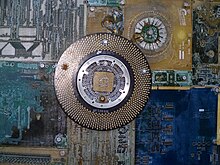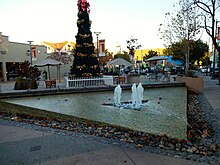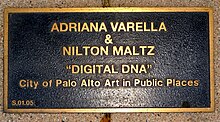
Digital DNA is a public art project commissioned by the Palo Alto Public Arts Commission for Lytton Plaza in downtown Palo Alto, California. It was created by Adriana Varella and Nilton Maltz and installed in 2005. Digital DNA addresses complicated themes of technology and public space in Silicon Valley. In 2018, the sculpture was removed from the plaza [1] and was later installed outside of the i-Lab at Harvard Business School. [2]
Digital DNA recognizes Palo Alto (indeed, the HP garage) as the birthplace of the Silicon Valley and the computer revolution. At the same time, the sculpture poses challenging questions about what it means to live and work in the Silicon Valley where every day companies determine and produce new technologies and make decisions that profoundly change the DNA of both it and every other society on the globe.[ citation needed]
Commission
The Palo Alto Public Arts Commission is primarily funded by the Palo Alto City Council and aims to beautify the city and support (often emerging) contemporary artists while contributing to the cultural life of the community. [3] In 2000, the seven member Commission approved the modern artwork Digital DNA for the 0.2-acre (810 m2) plaza on the corner of University Avenue and Emerson Street. [4] [5] [6]
Lytton Plaza


Lytton Plaza was created by Lytton Savings on a vacant lot next to the former Savings and Loan. During the 1960s, the plaza was the site of free rock concerts, noise complaints, anti-war demonstrations, and confrontations with police. [7] The plaza was eventually purchased by the City of Palo Alto.
Design
Digital DNA is a seven-foot-tall (by five feet across) egg-shaped sculpture made of welded steel [ citation needed] and recycled computer silicon circuit boards applied to polystyrene bead foam with an epoxy fiberglass skin, and finished with UV resistant polyurethane clear automotive paint. [4] [8] Sewn into the surface are phrases relating to technology in many languages (Arabic, Russian, French, Italian, Portuguese, Japanese, etc.). It goes deeper into branching, but above all into the origins of what comes to be the adventure of computers. Therefore, through phrases like: "Circuits of Power", "Ideological Circuits", "Warfare Circuits", "Borderless Circuits", "Sexual Circuits", "Colonizing Circuits", "Genetic Circuits, etc, trying to simplistically verify, even if it is a glimpse of consciousness, one of the main tools-objects of our contemporary world. [ citation needed]
The "egg" is meant to recognize Palo Alto as the birthplace of Silicon Valley. Linda Craighead, Palo Alto Arts Center Director, feels that the work represents "the power of technology to bring the world together." [9] Varella said of the design, "I don't want to preach truths, just trigger ideas. Lovers of Digital DNA say: "Digital DNA is the Identity of Palo Alto."
History and controversies
Thrown out with trash
Digital DNA was commissioned in 2000. In 2001, while moving from Palo Alto to San Francisco Varella used her shared garage to store unattached pieces of the artwork. Her neighbor mistook the unfinished work for junk, and threw it out. Varella lost six months of work. [10]
The installation of the piece was originally scheduled for May 8, 2004, but was delayed due to changes in city policy regarding the hiring of city vendors. By June an installer had been hired, and Digital DNA was ready to be installed; however, a conflicting plan for the complete redesign of the plaza had been made public. Former Palo Alto mayor Leland Levy and real estate developer Roxy Rapp proposed a $500,000 revitalization of Lytton plaza. The design featured a central fountain, but did not include Digital DNA. [6] [10]
On June 17, the Palo Alto Public Art Commission held a meeting to discuss the future of Digital DNA in relation to the fountain plan. Levy and Rapp requested that the installation of the artwork be further delayed until their proposal was formally presented to the City Council. The Commission unanimously voted to study the fountain plan, but also reiterated their desire for the immediate installation of Digital DNA. [6] [10]
Destroyed by fire
Following the vote, Arts and Culture Director Leon Kaplan, the city employee overseeing the project, made a shocking announcement. About a month prior, on May 19, there had been a fire in the San Bruno warehouse where Digital DNA was being stored. 11 days after the original installation date, Digital DNA was completely destroyed. [10]
Because the fire occurred after the installation of Digital DNA had been delayed by city staff, some public officials blamed its loss on city employees. Varella hired an attorney to investigate the city's liability for the loss. Suspicions rose that the fire had been masterminded to allow the fountain plan to move forward. [6] [10]
Insurance reimbursed the city for the cost of the lost sculpture. On August 19, 2004, the Commission voted to fund a second version of the artwork. [5] [11]
In late April 2005 Digital DNA was again ready to be displayed, however, the installation was slightly delayed due to weather and other factors. [12]
Dedication June 2005

The second iteration of Digital DNA debuted in Lytton Plaza in May, and was officially unveiled June 9–10, 2005 with a reception and dedication. [13] [14]
Vandalism
Two weeks prior to the unveiling, Digital DNA was vandalized. Six circuit boards were removed from the sculpture and several wires were pulled out, but Varella was able to repair the damages before the event. An earlier plan to install surveillance equipment in the plaza was reconsidered as a result of the vandalism. Police speculated that the crime was committed by drunken patrons of local bars. [9]
In April 2008, a public-private partnership (including city staff, Levy, and Rapp) renewed the 2004 undertaking to revitalize Lytton Plaza with a large-scale redesign. The old proposal, which did not incorporate Digital DNA, was never approved, but will be revisited. Levy expressed the group's desire to present a plan to which everyone can agree. According to Sunny Dykwel, a leader of the advocacy effort, Digital DNA is a beautiful piece of art, which they intend to protect. [15]
Vote to remove
In August 2017, the city staff issued a report recommending removal, because of the cost of maintenance. The staff was concerned about the continuing expense of maintaining a sculpture that does not hold up under outdoor weather conditions. The staff tried, but failed to find a suitable location within the city, for displaying the sculpture. [16]
In November 2017, the Arts Commission voted to remove the sculpture. In response, about 60 protesters gathered on December 7 at the sculpture. The artist wrapped the sculpture in a tarp labeled "CENSORED." [17]
Removal and relocation to Harvard
In 2018, the sculpture was purchased by an anonymous art collector, who is also a Silicon Valley entrepreneur and a Harvard University graduate. [18] The sculpture was removed from Lytton Plaza in June 2018. The art collectors wanted to have the sculpture repaired and restored. As of 2019 [update], the Harvard Business School displays the restored work outside the i-Lab on Western Avenue. [1] [19] [2]
Circuit adjectives
The adjectives imbue the logic of the circuitry with the emotion and other political, social or behavioral adjectives. These phrases are written in a variety of languages such as Japanese, Chinese, Vietnamese, Polish, Russian, German, Arabic, Indy, Philippine, Portuguese, French, Italian, Spanish, Hebrew and binary representation. The color is noted to help identify the board. Duplicates are noted. A question mark denotes lines that have yet to be properly translated.
Dividing the egg into four quadrants according to the clock (looking from above), and listing top-to-bottom, the adjectives are, at noon (near the DIGITAL DNA title board): cooperative, ideological, timeless, programmed, globalizing, genetic, timeless, warfare
White unidentified script (akin to Korean)
- ar: التحكم (control) دوائر (circuits) (As in perhaps ar:هندسة التحكم – control engineering) (on blue)
- ar: التفريق (differentiation? dispersing?) ar:دوائر (on olive green)
- de: de:wikt:kontrolliert (controlling) (spelled kontrolliert aide?) kreisläufe
- circuits fr:masturbateur
- he:מעגל (circuit/circle) ם ללא (without) he:גבול (borders)
- he:גלובליזציה (globalization) he:מעגל
- ja: (逍 or 檤?) ? ? 化する (does it)の回路
- ja:希望 (hope) の回路 (circuits)
- tl: Mga circuit na sumasakop (covering (?))
At 3 o'clock:
- isolating (repeat), globalizing (repeat), colonizing, borderless, artificial intelligence, mutating
- ar: الكتم (stuffiness?) دوائر
- de: serielle (serial, de:seriell) kreisläufe
- es:circuitos interactivos
- circuits d'illusion
- fr:circuits sexuels
- ja: 全世界 ? の回路 (worldwide)
- ja:ロボット (robot) の回路
- ja:マスメディア (mass media) の回路 (circuit)
- ru:кругообороты (circuit) ru: молчанн?
At six o'clock:
- transcorporeal, identifying, reproductive, simulating, idealizing, political, short circuits, circuits of the system, circuits of hope
- unidentified cursive script?
- ar: ا?يالية (huh) دوائر (on dark yellow fabric)
- he:מעגל (circuit/circle) he:מלחמה (war)
- it:circuiti it:aleatori (random)
- ja:力 (power, force) の回路
- ja: 遺伝子 (gene) の回路
- ja:ショート (short circuit) した (did) 回路
- ja:希望 (hope) の回路
- sv:programmering sv:kretslopp (cycle)
- идеологпческне (see ru:идеологический, ideological, ru:Идеология) ru:кругообороты (cycle)
- vi: đường dẫn (circuit, vi:Mạch in) vi:điện lực (electric power)
At 9 o'clock:
- hacking, transracial, nomad, globalizing (repeat), randomic, libertarian, isolating (repeat), biological, surveying
- ar: الئكتلدل ? (huh?) دوائر (on medium green, nar. vert.)
- ar: كنيسة (church?) دوائر (on light green, wide vert.)
- ar: مافها كن (Mavha?) (on medium green, nar. horiz.)
- الأمل (hope) دوائر (spelled without the (lām + ʼalif) ligature)
- binary: these are ASCII values: 1000100 1001110 1000001 (DNA)
- es:circuitos imaginários
- it:circuiti it:anecoici (Anechoic chamber)
- ja: 遣 ? イムチ (or そ)の回路
- ja:錯覚 (illusion) ? にる の回路
- ja:自爆 (self-destruct) する (does it) の回路
- 정치적인 (politics) ko:회로 (circuit)
- pt:circuitos pt:vazios (empty or null)
- ru:кругообороты ru:случай (chance) иостей ?
- vi: đường dẫn (circuit, Mạch in) bao quát (globalizing, vi:Toàn cầu hóa)
There are several Arabic lines starting with: دوائر (services) ? Compare to ar:دوران (rotation) or ar:دائرة (circle), but spelled like دوائر (services?). The board colors are provided as a navigation aid.
References
- ^ a b Kelly, Kevin (2018-06-26). "'Digital DNA' sculpture's run in downtown Palo Alto ends after 13 years". The Mercury News. Retrieved 2018-06-27.
- ^ a b "Harvard Business School is New Home for Digital DNA". Harvard Business School. 2018-11-27. Retrieved 2019-09-29.
- ^ Chandler, Elissa (May 5, 2006). "Palo Alto displays international artists' creations". The Paly Voice, Palo Alto High School Journalism Online: The Campanile. Archived from the original on 2006-12-31. Retrieved 2008-04-29.
- ^ a b "Digital DNA by Adriana Varella and Nilton Maltz". Archived from the original on 2007-09-16. Retrieved 2008-04-29.
- ^ a b D'Agostino, Bill (May 4, 2005). "Lytton Plaza egg to be hatched". Palo Alto Weekly Online Edition. Retrieved 2008-04-29.
- ^ a b c d Matt Bowling. "The Civic Art Gallery: "Digital DNA" and "Rrrun"". The Palo Alto History Project. Archived from the original on 2008-05-18. Retrieved 2008-04-29.
- ^ "The Lytton Plaza Protests: Rebels Without a Cause". Palo Alto History. Retrieved December 7, 2017.
- ^ "Lera Glass". Retrieved 2008-04-29.
- ^ a b "Around Town, Cracked egg". Palo Alto Weekly Online Edition. June 8, 2005. Retrieved 2008-04-29.
- ^ a b c d e D'Agostino, Bill (June 23, 2004). "'Digital DNA' lost in fire last month". Palo Alto Weekly Online Edition. Retrieved 2008-04-29.
- ^ "Minutes, Public Art Commission" (PDF). City of Palo Alto: Agenda and Minutes. August 19, 2004. Retrieved 2008-04-29.
- ^ D'Agostino, Bill (May 4, 2005). "Digital DNA installation slightly delayed". Palo Alto Online: News. Retrieved 2008-04-29.
- ^ "Digital DNA, Art on the Street (Palo Alto Public Art Commission)". Artsopolis.com. Archived from the original on 2011-07-07. Retrieved 2008-04-29.
- ^ D'Agostino, Bill; Jocelyn Dong; Alexandria Rocha (December 28, 2005). "From Anarchists to Zero Waste, Palo Alto's year in review, from 'A' to 'Z'". Palo Alto Weekly Online Edition. Retrieved 2008-04-29.
- ^ Kristina Peterson (April 29, 2008). "Downtown plaza up for redesign again, Public-private partnership in the works". Palo Alto Daily News. Retrieved 2008-04-29.
- ^ "City of Palo Alto Staff Report to Public Art Commission". Retrieved December 4, 2017.
- ^ Jacob Nierenberg (December 15, 2017). "Palo Alto residents, artist protest removal of 'Digital DNA' sculpture". Peninsula Press. Stanford University. Retrieved December 20, 2017.
- ^ Padojino, Jamey (2018-06-21). "Egg-hausted effort". Palo Alto Online. Retrieved 2018-06-27.
- ^ "The College Pump". Harvard Magazine. March 2019. p. 76.
